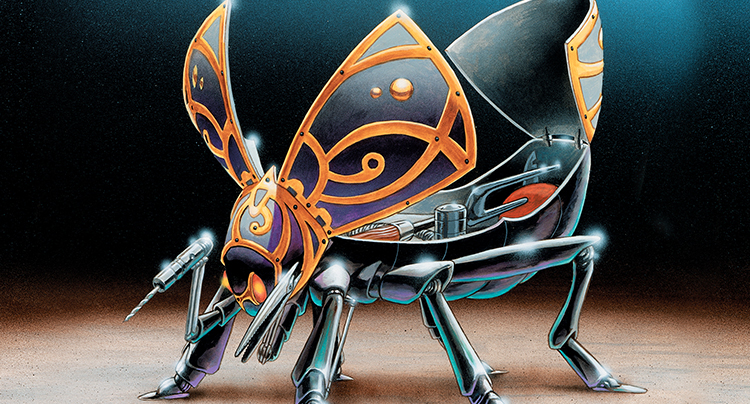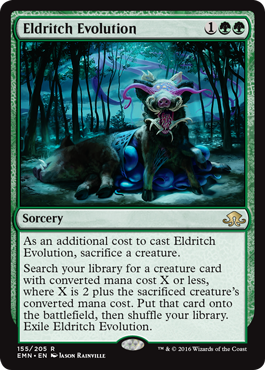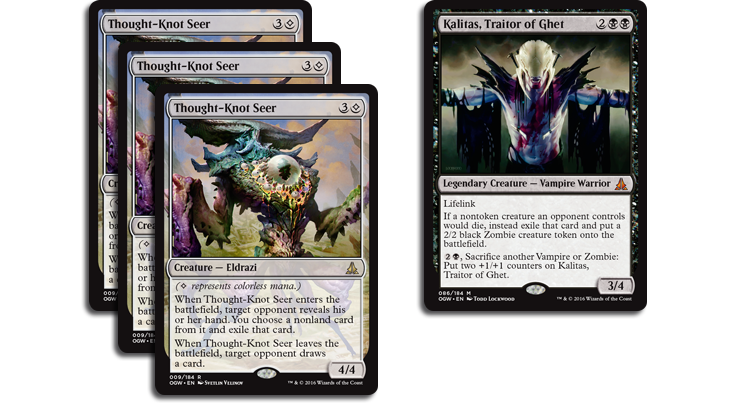Pandora's Toolbox
Let's say you're a repairman working on the outside of the 61st story of the Empire State Building.
You have to fill your toolbox with the right supplies before going up to make repairs. You want to have everything you need, because you're certainly not going to easily be able to go back down and grab more supplies.
But at the same time, everything you put into your toolbox (quite literally) weighs you down. You want to find the perfect equilibrium of having all the correct tools you might need while making sure nothing extraneous is sitting around adding on three additional pounds. What do you do?
Don't worry—this isn't some high-school math word problem. Welcome to building a Magic toolbox!

What is a toolbox in Magic terms? Great question!
A toolbox generally revolves around a card that can search for other cards. Often referred to as "tutors" (named after Enlightened Tutor, Vampiric Tutor, and the like), these cards are powerful because they let you find just the right answer at the right time.
If those cards are the outer casing of the toolbox, then the cards you search for are the tools you put inside. These are usually flexible one-ofs that you want to find in specific situations. For example, if you have Worldly Tutor in your deck, you might play exactly one Reclamation Sage so that if your opponent has a troublesome artifact or enchantment you can find the Sage and blow it up.
Of course, if their deck has no artifacts or enchantments and you draw the Sage normally, it's going to be frustratingly weak. And therein lies the question: Which tutor targets, and how many, am I supposed to put into my deck?
Today, I'm going to run through some advice and examples of how to build a toolbox. If only there was some incredibly powerful new card that encouraged you to build a toolbox....
Well, worry not, because there is. And it's quite a doozy. Prepare yourself!
Let me introduce you to my friend Eldritch Evolution:

Tutoring. Putting directly onto the battlefield. Three mana. Nothing has ever been broken with cheating mana costs from your library directly onto the battlefield before, right?
When I see a card like this, my toolbox gears start turning. The natural thing to want to do is build up some decks that allow you to have the perfect threat or answer at every turn. There are plenty of permutations and options in front of you.
So, you want to include Eldritch Evolution in your deck as a toolbox card. How do you choose which cards go into your toolbox?
Let's explore a few ways—and build a deck to talk about, to boot!
The Combo Toolbox
Toolboxes and combo decks tend to go hand-in-hand. When you're searching for specific cards, tutors provide you redundancy to find the cards you're looking for. If your combo pieces are clunky and you don't want to draw a ton of them, it also means you can play fewer of the individual pieces and let the tutor be find whichever piece you're missing.
But on top of just finding that redundancy, people often like to hate out combo decks—and tutors mean you can find the right card to answer their hate so you can go off.
Let's apply this to Eldritch Evolution.
One combo deck running around Standard right now just so happens to also be creature-based. The combo of Eldrazi Displacer and Brood Monitor lets you create unbounded numbers of enters-the-battlefield and dies triggers by using the tokens Brood Monitor creates to repeatedly flicker out Brood Monitor. It doesn't really do anything on its own—but throw anything like a Zulaport Cutthroat into the mix and your opponent is instantly dead.
This deck has seen some success already—and with Eldritch Evolution as a tutor that puts the creature directly onto the battlefield, it's poised to become stronger than ever.
For example, check out this decklist:
There are a few interesting things going on here.
First of all, look how tight the combo package can be. With only one Zulaport Cutthroat (also findable with Catacomb Sifter) and two Brood Monitors, you get to shave a couple necessary spots.
Note that you need a couple four-drops to make sure you can Evolution into Brood Monitor. Fortunately, Thought-Knot Seer fits the bill perfectly! It's an attractive card to search up with Evolution to clear your opponent's hand before trying to combo off—and a fine card to draw and cast on its own before comboing out.
Finally, note that one-of Kalitas. Though its ability doesn't affect tokens, in a mirror match it can make a major impact. If you happen to face something like the Black-Green Cryptolith Rite deck, it can be completely devastating—to the point where searching for it provides tons of time to set up your win.
You could also easily play a variety of different mirror-match one-ofs. Enlightened Ascetic, for example, to blow up their Cryptolith Rite. If you add in more Reflector Mages—which very much might be correct—you could also play a Reality Smasher to search up. Whatever your metagame is, there's probably a card you could tutor up for it.
What are some of the ways you can build your toolbox? Well...
Split Toolbox
There are some cards that are pretty easy to play as toolbox targets because they're entirely reasonable in your deck anyway!
Take the aforementioned Enlightened Ascetic. On its own, it's pretty weak, and it is only good in specific situations. This isn't a kind of card you would normally play main deck unless you had a toolbox and the metagame called for it.
Compare that to Kalitas, Traitor of Ghet. Kalitas is plenty strong in its own right. And while you probably wouldn't normally play one in that deck, if you draw it it's certainly going to be fine most of the time. This makes it a great choice for a toolbox card because sometimes you do just draw your one-ofs—and you'd rather they were impactful than dead cards in your hand.
Something you can do in a lot of toolbox decks is what I call the "split method."
Let's say you are normally going to play four copies of a card. Let's say you'd normally play four Thought-Knot Seers. Totally reasonable; it's a strong card. However, you also want to play Kalitas as a situational metagame card. Kalitas is also a four-drop. They're both pretty strong. Thought-Knot is the more general all-purpose card, but Kalitas can certainly shine far brighter in some matchups.
What should you do?
What you can do is split them three and one.

This lets you have the card you generally think is better most of the time—but having one Kalitas in your deck allows you to tutor for it when you really need it. And, as previously noted, Kalitas is totally fine to draw in its own right and will be sometimes better than the Seer.
This kind of three-and-one (or sometimes two-and-one or one-and-one) is the split method at work.
In a deck with a toolbox, the difference between zero and one is tremendous. If there's something you really want access to, consider using the split method to make it work.
Fix Your Weaknesses
A key strength of toolbox decks is their ability to shore up situational weaknesses with individual cards.
For example, let's say that a graveyard reanimator deck with Ever After becomes popular. They dump a bunch of strong creatures into their graveyard and then plan to reanimate them. You discover you have a bad matchup against this deck.
Far from every opponent is going to be playing this Ever After deck. But in the games where you play against it, you really struggle to win. The Ever After deck begins to creep up in numbers.
What are you supposed to do?
Well, it's time to main deck a creature to fight against it.
These kinds of "silver bullets" are targeted at a specific deck or strategy. Playing a graveyard-hate creature costs you one spot in your deck and can completely turn the matchup around if you can Evolution for it. It's worth playing because this one spot alone swings that matchup in your favor.
More than combo or aggressive decks with toolboxes, you'll most often see this in control decks that sport a toolbox.
Control decks plan to take the game long, and they need to have the appropriate answer for a myriad of decks. For example, if you're playing Mystical Teachings and a reanimator deck is popular, it's absolutely worth playing one card to fight it if you don't think you can beat it normally.
This is always an important tactic to keep in mind—but it's also important to show restraint. Because I have one crucial parting piece of advice to bring up.
Overstuffed Toolboxes
By far the number-one mistake I see with toolbox decks is to put in too many singleton toolbox targets.
Every toolbox target you put in feels so easy and simple. It's just one card. But if you do that ten times, suddenly you have ten suboptimal situational cards in your deck!
The key when adding in any toolbox target is to ask yourself, "Do I really need this?"
For example, it's an immediate instinct to put in something like a Caustic Caterpillar to remove any artifacts or enchantments. After all, certain artifacts and enchantments are your prototypical "situationally-need-to-remove-it" cards. But if nobody is actually main-decking any artifacts you drastically need to remove, then you're just spending a slot in your deck without a consistent return!
Five similar, common singleton main-deck mistakes along these lines include playing toolbox targets that:
- Fight a deck that nobody really plays
- Are good in a situation that almost never comes up
- Help against a deck you're already favored against anyway
- You're almost never going to go find over something else
- Is strong against a card people don't have in their main decks that only shows up after sideboards
As you're playtesting and playing, pay attention to what you're searching for and how often. If there are cards you just never search up, that's a pretty good sign you should take them out.
In general, if you have four or more singleton targets in your deck, I would start examining the reason for each. At that point, you're taking up a full playset of space in your library for these singletons—and each of them had better be worth it. (Or you're going to need to be okay with naturally drawing them sometimes.)
The Tools for the Job
Toolbox decks are some of my favorite decks to play in all of Magic. There's something to be said for the feeling of rifling through your deck, looking for the perfect singleton answer to your opponent's play.
These decks have to be built carefully—and when done properly, they can be quite powerful. Hopefully, you now have the tools to go out and build your own! I look forward to seeing what you can do with Eldritch Evolution; it's a powerful card that lets you find exactly what you're looking for.
Any thoughts, questions, gameplay situations, or sweet brews with Eldritch Evolution? I'd love to hear from you!
You can always reach me on Twitter or Tumblr. That's the best way to find me—but if email is better for you, you can also write me at beyondbasicsmagic@gmail.com.
I'll be back next week with a pair of Eldritch Moon preview cards, as we talk about building tribal decks. Until then, enjoy Eldritch Moon preview season—and may you always have just the tool for the job!

